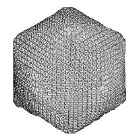Plant Pathology, Department of

James Van Etten Publications
Document Type
Article
Date of this Version
2016
Citation
Cellular Microbiology (2016) 18(1), 3–16
doi:10.1111/cmi.12486
PMID: 26248343 https://www.ncbi.nlm.nih.gov/pubmed/26248343
Abstract
The increasing interest in cytoplasmic factories generated by eukaryotic-infecting viruses stems from the realization that these highly ordered assemblies may contribute fundamental novel insights to the functional significance of order in cellular biology. Here, we report the formation process and structural features of the cytoplasmic factories of the large dsDNA virus Paramecium bursaria chlorella virus 1 (PBCV-1). By combining diverse imaging techniques, including scanning transmission electron microscopy tomography and focused ion beam technologies, we show that the architecture and mode of formation of PBCV-1 factories are significantly different from those generated by their evolutionary relatives Vaccinia and Mimivirus. Specifically, PBCV-1 factories consist of a network of single membrane bilayers acting as capsid templates in the central region, and viral genomes spread throughout the host cytoplasm but excluded from the membranecontaining sites. In sharp contrast, factories generated by Mimivirus have viral genomes in their core, with membrane biogenesis region located at their periphery. Yet, all viral factories appear to share structural features that are essential for their function. In addition, our studies support the notion that PBCV-1 infection, which was recently reported to result in significant pathological outcomes in humans andmice, proceeds througha bacteriophage -like infection pathway.


Comments
© 2015 John Wiley & Sons Ltd
Access via Pub Med